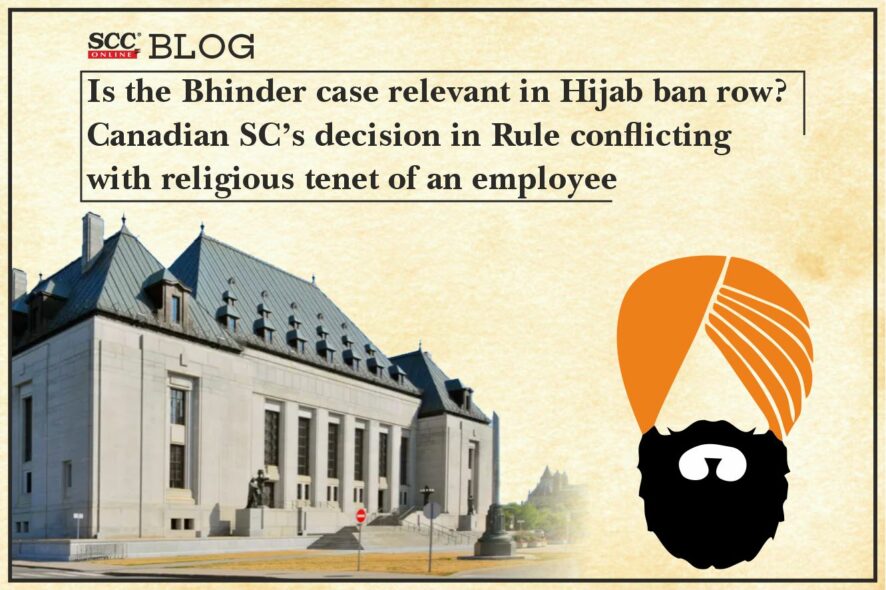As the proceedings in the Hijab Case are still going on, here we try and look back at one of the decisions from a foreign Court, which addressed the issue with regard to right to practice religion.
In today’s post we look at a case from Canada Supreme Court from the year 1985.
Remember what Canada Supreme Court ruled out in K.S. Bhinder v. Canadian National Railway Company, 1985 SCC OnLine Can SC 76, Case?
In this case, a work rule was introduced, as per which all the employees had to wear a hard hat at a particular work site, but Bhinder a Sikh employee refused to comply with the said rule because his religion did not allow the wearing of headgear other than the turban.
Due to the above said, Bhinder’s employment was ceased but the Canadian Human Rights Tribunal found that the said rule was discriminatory in practice and ordered reinstatement and compensation for loss of salary. Though when the matter was appealed, the decision was set aside and referred back for disposition on the basis that the work rule was not a discriminatory practice.
As per Section 14 of the Canadian Human Rights Act,
“It is not a discriminatory practice:
(a) any refusal, exclusion, expulsion, suspension, limitation, specification or preference in relation to any employment is established by an employer to be based on a bona fide occupational requirement;”
In Court’s opinion, the Tribunal did not err in law in holding the bona fide occupational requirement of Section 14 (a) of the Act.
“The wearing of safety helmets by Sikhs, a requirement which has a prima facie discriminatory effect, is a matter governed by the Canadian Human Rights Act, not the Canada Labour Code, where the requirements of the two Acts conflict. Thus, even if the safety helmet policy is necessary under the Canada Labour Code and Regulations, it does not follow that the policy is ipso facto a bona fide occupational requirement for the purpose of the Canadian Human Rights Act.”
“With respect to the financial hardship of Canadian National in the event of an injury to Mr. Bhinder as a result of his not wearing a safety helmet, the Tribunal concluded the potential additional costs of an exemption from its safety helmet policy in favour of the complainant, and Sikhs in general, was de minimis and, therefore, did not constitute undue hardship.”
Further, it was noted that, the Tribunal found that the rule was useful, that it was reasonable in that it promoted safety by reducing the risk of injury and, specifically, that the risk faced by Bhinder in wearing a turban rather than a hard hat was increased, though by a very small amount. The only conclusion that can be drawn from the reasons for the decision is that, but for its special application to Bhinder, the hard hat rule was found to be a bona fide occupational requirement. Indeed, it would be difficult on the facts to reach any other conclusion.
The conclusion in the said case was that the safety helmet policy of the employer was not a bona fide occupational requirement in respect of its application to Mr Bhinder.
“The Tribunal found that the rule was useful, that it was reasonable in that it promoted safety by reducing the risk of injury and, specifically, that the risk faced by Bhinder in wearing a turban rather than a hard hat was increased, though by a very small amount. The only conclusion that can be drawn from the reasons for decision is that, but for its special application to Bhinder, the hard hat rule was found to be a bona fide occupational requirement. Indeed, it would be difficult on the facts to reach any other conclusion.”
Supreme Court of Canada found error in law for the Tribunal, having found that the bona fide occupational requirement existed, to exempt the appellant from its scope.
What the UN Human Rights Committee held in the case?
Whether the imposition of a ‘hard hat’ policy for reasons of workplace safety was incompatible with Article 18 of the International Covenant on Civil and Political Rights, where particular religious groups were unable to comply with the requirement?
While holding that, the facts of the case did not disclose a violation of any provision of the International Covenant on Civil and Political Rights, Committee noted that,
“If the requirement that a hard hat be worn is regarded as raising issues under article 18, then it is a limitation that is justified by reference to the grounds laid down in article 18, paragraph 3. If the requirement that a hard hat be worn is seen as a discrimination de facto against persons of the Sikh religion under article 26, then, applying criteria now well established in the jurisprudence of the Committee, the legislation requiring that workers in federal employment be protected from injury and electric shock by the wearing of hard hats is to be regarded as reasonable and directed towards objective purposes that are compatible with the Covenant.”
[KARNEL SINGH BHINDER v. CANADA, 23 October – 10 November 1989]
How the Kerala High Court had dealt with the wearing of ‘headscarf’ issue? Read below
To Wear or Not to Wear? Precedents on dilemma of wearing ‘Headscarf’ from the Kerala High Court






